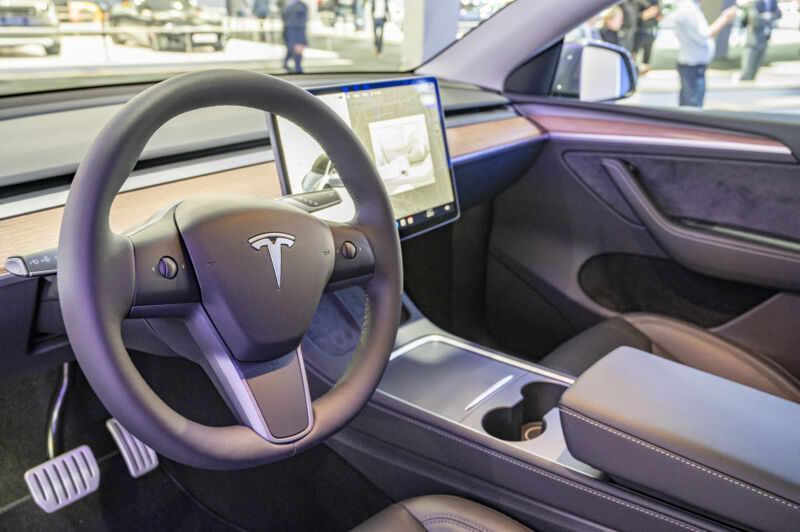toxic waste, seriously? —
There have been 2,388 complaints about steering failure in the Model 3 and Model Y.

Enlarge / More than 2,000 Tesla model-year 2023 Model Y and Model 3s have suffered steering failure, according to a new NHTSA safety defect investigation.
Sjoerd van der Wal/Getty Images
It’s been a rough week for Tesla. On Tuesday, a court in Delaware voided a massive $55.8 billion pay package for CEO Elon Musk. Then, news emerged that Tesla was being sued by 25 different counties in California for years of dumping toxic waste. That was followed by a recall affecting 2.2 million Teslas. Now, Ars has learned that the National Highway Traffic Safety Administration’s Office of Defects Investigation is investigating the company after 2,388 complaints of steering failure affecting the model-year 2023 Model 3 sedan and Model Y crossover.
Paint, brake fluid, used batteries, antifreeze, diesel
Tesla has repeatedly run afoul of laws designed to protect the environment from industrial waste. In 2019, author Edward Niedermeyer cataloged the troubles the company ran into with air pollution from its paint shop in Fremont, California, some of which occurred when the automaker took to painting its cars in a temporary tent-like marquee.
In 2022, the US Environmental Protection Agency fined Tesla $275,000 for violating the Clean Air Act, which followed a $31,000 penalty Tesla paid to the EPA in 2019. But EPA data shows that Tesla continued to violate the Clean Air Act in 2023.
And on Wednesday, Reuters reported that 25 Californian counties sued Tesla for violating the state’s hazardous waste laws and unfair business laws by improperly labeling hazardous waste before sending it to landfills that were not able to deal with the material.
The suit alleged that violations occurred at more than 100 facilities, including the factory in Fremont, and that Tesla disposed of hazardous materials including “but not limited to: lubricating oils, brake fluids, lead acid batteries, aerosols, antifreeze, cleaning fluids, propane, paint, acetone, liquified petroleum gas, adhesives and diesel fuel.”
Despite potentially large penalties for these industrial waste violations, which could have resulted in tens of thousands of dollars of fines for each day the automaker was not compliant, the counties and Tesla swiftly settled the suit on Thursday. Tesla, which had annual revenues of $96.8 billion in 2023, will pay just $1.3 million in civil penalties and an additional $200,000 in costs. The company is supposed to properly train its employees and hire a third party to conduct annual waste audits at 10 percent of its facilities, according to the Office of the District Attorney in San Francisco.
“While electric vehicles may benefit the environment, the manufacturing and servicing of these vehicles still generates many harmful waste streams,” said District Attorney Brooke Jenkins. “Today’s settlement against Tesla, Inc. serves to provide a cleaner environment for citizens throughout the state by preventing the contamination of our precious natural resources when hazardous waste is mismanaged and unlawfully disposed. We are proud to work with our district attorney partners to enforce California’s environmental laws to ensure these hazardous wastes are handled properly.”
An easy recall, a not-so-easy defect investigation
Tesla’s latest recall is a big one, affecting 2,193,869 vehicles—nearly every Tesla sold in the US, including the Model S (model years 2012–2023), the Model X (model years 2016–2024), the Model 3 (model years 2014–2023), the Model Y (model years 2019–2024) and the Cybertruck.
According to the official Part 573 Safety Notice, the issue is due to the cars’ displays, which use a font for the brake, park, and antilock brake warning indicators that is smaller than is legally required under the federal motor vehicle safety standards. NHTSA says it noticed the problem as part of a routine compliance audit on a Model Y in early January. After the agency informed the automaker, Tesla looked into the issue itself, and on January 24, it decided to issue a safety recall. Fortunately for the automaker, it can fix this problem with a software update.
A software patch is unlikely to help its other safety defect problem, however. Yesterday, NHTSA’s ODI upgraded a preliminary evaluation (begun in July 2023) to a full investigation of the steering components fitted to model-year 2023 Models 3 and Y.
NHTSA’s ODI says the problem affects up to 334,569 vehicles, which could suffer a loss of steering control. There have been 124 complaints of steering failure to NHTSA, and the agency says Tesla identified a further 2,264 customer complaints related to the problem. So far, at least one Tesla has crashed as a result of being unable to complete a right turn in an intersection.
A third of the complaints were reported to have happened at speeds below 5 mph, with the majority occurring between 5 and 35 mph and about 10 percent occurring above 35 mph (at least one complaint alleges the problem occurred at 75 mph). “A majority of allegations reported seeing a warning message, ‘Steering assist reduced,’ either before, during, or after the loss of steering control. A portion of drivers described their steering begin to feel ‘notchy’ or ‘clicky’ either prior to or just after the incident,” NHTSA’s investigation said.
NHTSA says there have been “multiple allegations of drivers blocking intersections and/or roadways,” and that more than 50 Teslas had to be towed as a result of the problem. The problem appears to be related to two of the four steering rack part numbers that Tesla used for these model-year 2023 EVs. They were installed in 2,187 of the vehicles, according to the complaints.